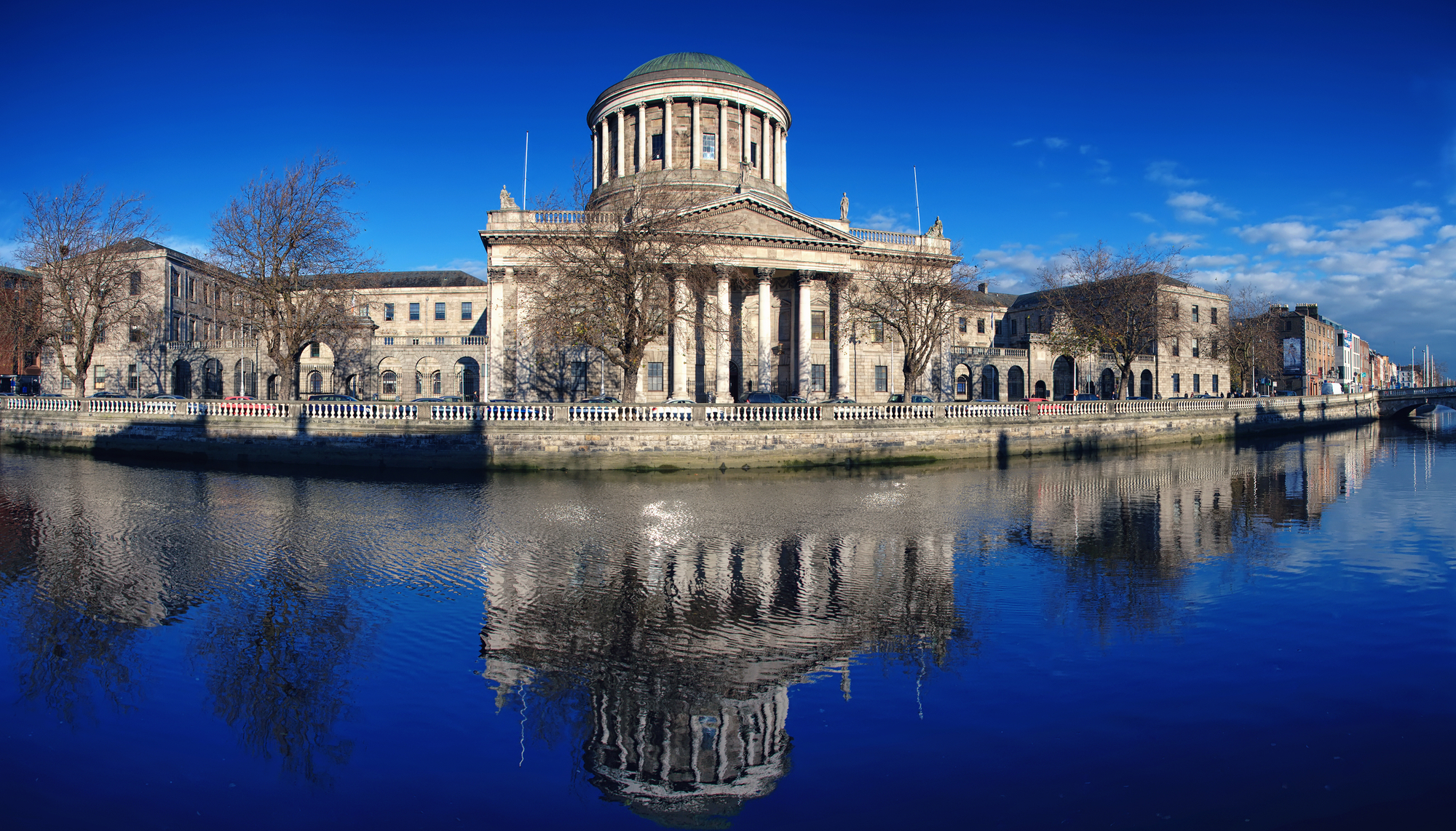Four Courts – Along the River Liffey in Dublin, Ireland

Updated On: April 08, 2024 by Ciaran Connolly
Dublin, the vibrant capital of Ireland, is a city that effortlessly blends its rich history with modernity. Among its many historic landmarks, the Four Courts stands out as a beacon of legal and architectural significance. Perched majestically along the River Liffey, this iconic building not only houses the highest courts in the land but also tells a story that spans centuries, wars, and the evolution of Irish law and justice. This article takes an in-depth look at the Four Courts, exploring its history, architecture, role in Ireland’s past, and enduring importance in the present.
Table of Contents
The Historical Origins
Prior to the construction of the Four Courts, the legal profession in Dublin was fragmented across various locations, including the overcrowded Dublin Castle and the Inns of Court. The burgeoning legal profession and the increasing complexity of legal proceedings in Ireland necessitated a more suitable and centralized location. The decision to build the Four Courts was not merely a response to a functional need; it represented a desire to establish a symbol of judicial authority and architectural splendour that befit the growing importance of Dublin as a centre of law and governance.
The Vision of James Gandon
James Gandon, an architect of significant repute, was tasked with designing the Four Courts. Gandon, an Englishman, had already made his mark in Dublin with the construction of the Custom House and the King’s Inns, showcasing his prowess in neoclassical architecture. His vision for the Four Courts was to create a structure that would embody the dignity and grandeur of the law. He envisaged a building that was not just functional but also aesthetically imposing, befitting the stature of Ireland’s highest legal institution.
Laying the Foundations: Challenges and Delays
The foundation stone of the Four Courts was laid in 1776, heralding the beginning of what would be a lengthy and challenging construction process. The project was fraught with financial and political difficulties, reflecting the turbulent times Ireland was going through, including the Irish Rebellion of 1798. Despite these obstacles, construction progressed, albeit slowly, under Gandon’s diligent supervision. The architect faced numerous challenges, from funding shortages to logistical issues, but his commitment to the project remained unwavering.
Architectural Features of the Four Courts
The architectural design of the Four Courts is a fine example of the neoclassical style, characterized by grandeur, symmetry, and the use of classical elements. The building features a majestic dome, which dominates the Dublin skyline and is flanked by two curved wings. These wings house the four courts – Chancery, King’s Bench, Exchequer, and Common Pleas – which gave the building its name. The façade of the Four Courts, with its impressive columns and portico, reflects the influence of ancient Greek and Roman architecture, a hallmark of Gandon’s designs.
The interior of the Four Courts is equally remarkable. The central hall under the dome is a space of immense grandeur, with its circular shape, intricate detailing, and the deployment of light and space. The courtrooms, with their wood-panelled walls and ornate ceilings, exude a sense of solemnity befitting judicial proceedings.
The Opening and Early Years
After decades of construction, the Four Courts was finally opened in 1802. It quickly became the hub of legal activity in Ireland, housing the highest courts of law. The building’s opening was a moment of pride for Dublin and was seen as a symbol of Ireland’s legal and architectural maturation.
Inside the Courts: The Heart of Irish Justice
Today, the Four Courts remains the seat of the Republic of Ireland’s Supreme Court, Court of Appeal, High Court, and Dublin Circuit Court. The functioning of these courts underlines the building’s ongoing relevance as the epicentre of legal proceedings in the country. Significant cases that have shaped Irish law and society have been argued and judged within its walls, continuing a tradition that has been alive since the early 19th century.
Visiting the Site
For visitors, the Four Courts offer more than just architectural grandeur. Guided tours provide insights into Ireland’s legal history and the functioning of its justice system. The experience of walking through the halls where some of the most important decisions in the country’s history have been made is both humbling and awe-inspiring.
The River Liffey
Flowing through the heart of Dublin, the River Liffey is more than just a natural waterway; it’s the lifeblood of the city, shaping its history, culture, and everyday life. Originating in the Wicklow Mountains, the river meanders for approximately 125 kilometres before emptying into the Irish Sea at Dublin Bay. As it courses through the city, the Liffey not only splits Dublin into the Northside and Southside but also weaves a narrative that is intrinsically linked to the capital’s identity.
Historically, the River Liffey has played a crucial role in Dublin’s development. It provided a vital trade route for the Vikings, who were among the city’s early settlers. The river’s banks witnessed the growth of medieval Dublin and, later, the expansion of the city during the Georgian era. It was along the Liffey where the iconic Ha’penny Bridge was erected in 1816, becoming a symbol of Dublin’s charm and character. Over time, the Liffey has been central to the city’s economy, with its ports bustling with activity and facilitating trade and commerce.
However, the River Liffey’s significance transcends its economic contributions. It’s the setting for many of Dublin’s cultural and social activities. The riverbanks are lined with a variety of landmarks and attractions, from historic buildings like the Custom House to modern structures such as the Bord Gáis Energy Theatre. The annual Liffey Swim, a tradition since 1920, is a testament to the river’s enduring place in the hearts of Dubliners.
The Liffey also enhances Dublin’s aesthetic appeal. The river reflects the city’s skyline, a mix of old and new architecture, creating picturesque vistas. Walking along the river, especially at dawn or dusk, offers peaceful yet vibrant scenes, as the city’s lights dance on the water’s surface.
In literature and music, the Liffey is a muse, inspiring poets and songwriters who capture its essence in their works. It is both a symbol of Dublin’s resilience and a witness to its ever-evolving story. For locals and visitors alike, the River Liffey is not just a body of water; it’s a part of Dublin’s soul – a constant in a city that is always changing.
The Four Courts and the River Liffey
The relationship between the Four Courts and the River Liffey is both aesthetic and symbolic. The building’s prominent position along the river not only enhances Dublin’s cityscape but also symbolizes the flow of justice and the law as the lifeblood in the heart of the nation. The River Liffey, a central artery in Dublin’s geography and history, adds a picturesque quality to the imposing presence of the courts.
Their Legacy and Future
As Ireland continues to evolve, the role and importance of the Four Courts also adapt. The building, while a symbol of tradition, is also a site of ongoing change and modernization, reflecting the dynamic nature of the law itself. The Four Courts remains a pivotal institution in Irish society, representing the rule of law, the pursuit of justice, and the complex layers of Irish history.
Conclusion
The Four Courts is more than a landmark; it is a living monument to Ireland’s legal, political, and architectural heritage. Standing proudly along the River Liffey, it tells a story of triumph and tragedy, resilience, and renewal. For anyone seeking to understand the soul of Dublin and the spirit of its people, a visit to the Four Courts is essential. It stands as a reminder of the past, a witness to the present, and a symbol of the future of justice and law in Ireland.






